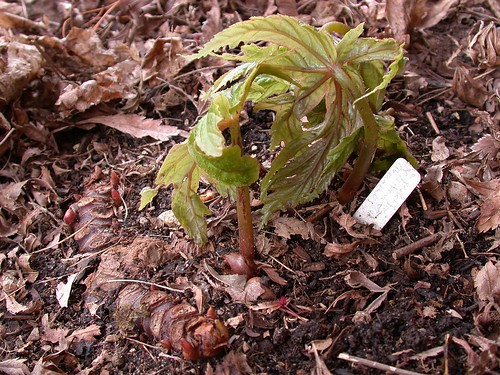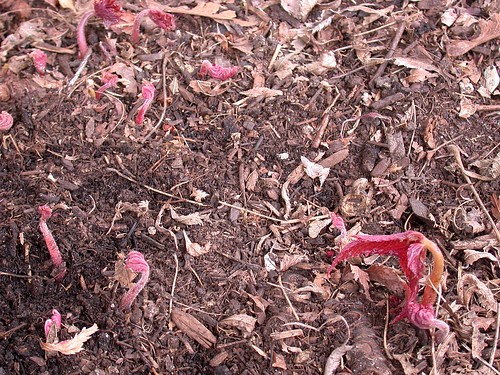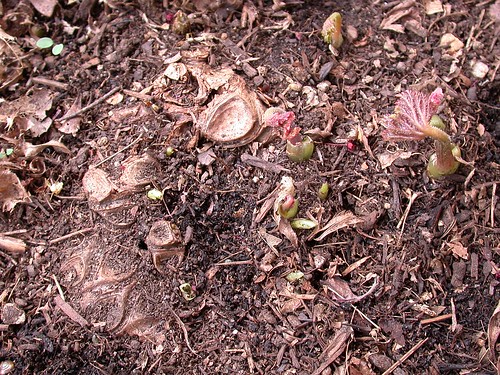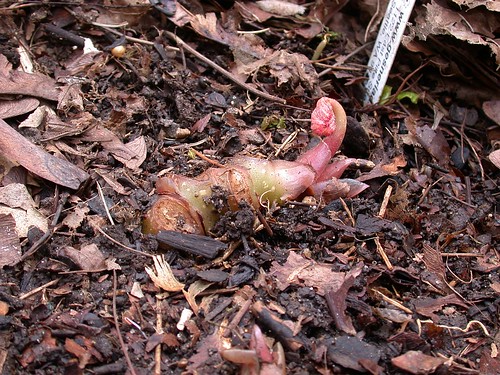
Begonia pedatifida showing creeping rhizome and new growth
To most gardeners, "hardy begonia" means Begonia grandis, a tuberous species from China that for years has been considered the only reliably hardy member of this huge but mostly tropical and subtropical genus. That has changed as recent collections in China have turned up a number of rhizomatous species that are also fairly hardy. I'm trialing several of these in my zone 7 garden (see But where are all the begonias?) and some of them are already emerging after my area's coldest winter in 20 years.
I already knew these particular plants were relatively hardy, as they had survived one or two previous winters in the ground. The difference this time around is that the winter was so much colder, and all of them were protected with only a light mulch of compost and autumn leaves. As with most rhizomatous begonias, the rhizomes creep on the soil surface where they are the most exposed to cold temperatures. This makes their survival that much more impressive. Another surprise is that--unlike B. grandis, a notoriously late riser--all of these started sending out new growth by mid-April.
I'm still waiting to see whether several more species and hybrids will emerge, but in the meantime these survivors inspire the hope of producing hardier hybrids. To my great frustration I have had very little luck in producing any crosses between these species and other species or hybrids. I wish other breeders better luck!
Begonia pedatifida (photo at top) has several slightly different clones now in cultivation. The deeply lobed leaves are fairly unusual in the genus. This was the earliest of my begonias to stir (see signs of life), showing new growth in late March.

Begonia U584 is similar to B. pedatifida. It may be a variant of that species, a closely related species, or perhaps a natural hybrid involving B. pedatifida. The leaves are not as deeply lobed and are much darker in color, with deep red-purple undersides. The male flowers have always aborted before opening, leading me to think it's probably a hybrid.

Begonia emeiensis is a large-growing and rather ungainly species, of interest almost exclusively because of its hardiness. It demands constant moisture, wilting and getting crispy leaf edges if it dries out even slightly. The deep pink flowers are large but are usually hidden under the foliage. This species produces a very large, thick rhizome that I expected to turn to mush after several extended periods below freezing, but they remained quite firm.

Begonia chitoensis, a species from Taiwan, is a bit of a surprise as it has returned after previous winters very late, very weakly, and only from deeply buried sections of rhizome. This time around, after a much colder winter, the rhizomes right at the surface are firm and already sending out new growth. I can't figure it out. The large leaves are handsome in an understated way.
What other begonias will emerge over the next few weeks? I'm sure there will be many disappointments, but (I hope!) some surprises as well. Watch for an update late this spring!

Great info! Thanks!
ReplyDeleteGlad you're finding my blog interesting, Rick!
DeleteGreat info and looking forward to seeing them in full leaf! We have the first two and on the look out for more hardy ones.
ReplyDeleteWhat's your thoughts on Begonia palmata? We also have Begonia Metallic Mist that has proven hardy for many years now.
I love B. palmata but the clones I've tried haven't done well in my summer heat. I had one collection survive a mild winter so I suppose I should try more collections of this very widespread and variable species. B. 'Metallic Mist' returned for me for several years, I never loved it and it seems to be completely sterile so I removed it to make room for other begonias.
DeleteSeems like you may be surprised. Of course, we did not have any freezes or frosts here, so everything is HUGE, especially canes. Keep us posted John....:-))
ReplyDeleteI would love to grow some really huge begonias, but that means growing them large before planting them out. The ones that are hardy are killed to the ground every winter and have to start from scratch each spring. 'Caribbean Star' and U508 grew the biggest and gave me the greatest "oomph" in a single growing season, coming back from established rhizomes. 'Little Brother Montgomery' never gets huge, but the color & pattern pack a big punch even on smaller plants. (BTW 'Caribbean Star', U508, and 'Little Brother Montgomery' all seem to have firm stems below ground, so I'm crossing my fingers!)
DeleteGreat info. Can you suggest a source that might have some of these for sale?
ReplyDeleteTry Plant Delights Nursery for several hardy begonias; Tony Avent is trialing several potentially hardy begonia species and hybrids, so you may see more of them available from PDN in the future. Otherwise I'm not sure who might be selling these plants as I've obtained virtually of of my begonias from trades with other growers.
DeleteThanks for doing the hard work that we can all (eventually) benefit from...
ReplyDeleteNot hard work at all--I've had great fun experimenting with these plants!
DeleteThis is great news, John.
ReplyDeleteThanks, and I hope to have more good news over the next few weeks! It's still too early for most of my other begonias, and not even B. grandis is up yet.
DeleteI'm Happy to see your garden. I have always so many things to learn, again and again . Merci pour vos indications. Merci de nous laisser regarder votre Jardin !
ReplyDeleteThank you, I'm glad you've enjoyed it!
Delete